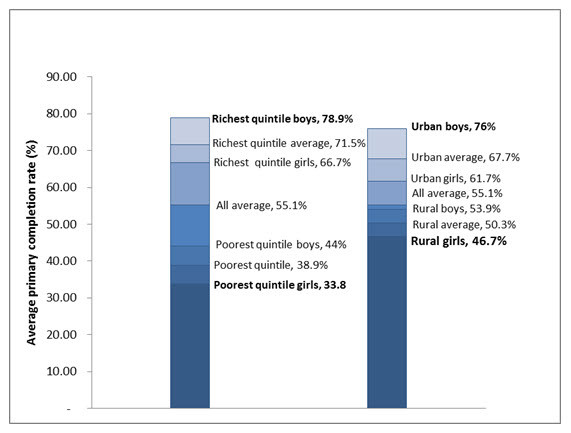Brooking scholars have done extensive research on policy issues focused on women and girls, especially in education. In observance of United Nations’ International Day of the Girl Child, here are some charts highlighting some issues where gender and education intersect. Visit the Center for Universal Education for the latest research on girls’ education.
GIRLS ARE DISADVANTAGED IN SECONDARY SCHOOL GLOBALLY
Rebecca Winthrop, director of the Center for Universal Education, and Eileen McGivney studied disadvantages faced by girls attending secondary school. Analyzing 2012 data, they found that while in 51 countries girls outpaced boys in secondary school enrollment, in 56 countries girls lagged boys, while in an additional 23 countries girls were severely disadvantaged in enrollment. This means that despite both boys and girls experiencing enrollment disadvantage in about the same number of countries, the number of countries in which girls are severely disadvantaged is nearly quadruple those in which boys are severely disadvantaged. Winthrop and McGivney identified these “girls’ education hotspots” across Asia and sub-Saharan Africa where, they note, many girls are married before 18, struggle with enrollment, “and in at least 15 countries [face] attacks on their lives for participating in education.”

MORE FEMALE STEM TEACHERS MAY INCREASE GENDER EQUALITY IN STEM
Michael Hansen, director of the Brown Center on Education Policy, and Diana Quintero examined whether increasing numbers of female teachers disadvantage boys in the education system. They found that while research shows that the presence of female professors results in higher grades and enrollment for female science, technology, engineering, and math (STEM) students, there is no research that suggests that this has a negative effect on male participation or outcomes. “In other words,” Hansen and Quintero wrote, “having more women leading math and science K-12 classrooms could actually be a preferred strategy to promote more gender equity in workforce outcomes.”

IDENTIFYING THREE TYPES OF GENDER EDUCATION INEQUALITY
Elizabeth King, a nonresident senior fellow with the Center for Universal Education, examined three types of global gender education inequalities, and outlined four obstacles to improving girls’ education worldwide. She argued that both direct and indirect costs of attending school are higher for girls, and that social norms and expectations including marriage keep girls out of school. In order to address these inequalities, there must be gender-based systemic reform.
The Brookings Institution is committed to quality, independence, and impact.
We are supported by a diverse array of funders. In line with our values and policies, each Brookings publication represents the sole views of its author(s).






Commentary
Charts of the Week: Gender and education
October 11, 2019